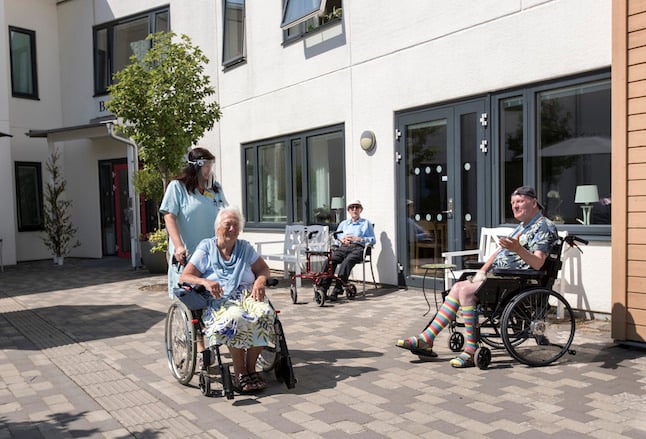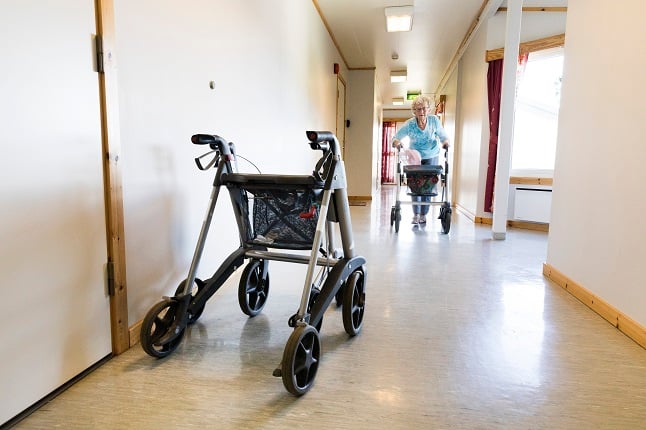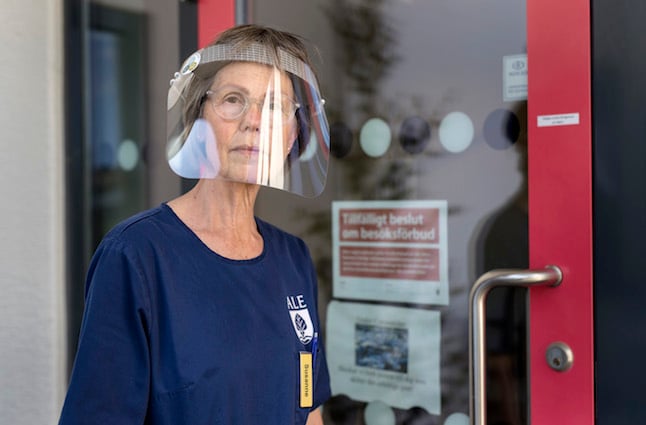Swedish care homes' response to coronavirus investigated in new report

Sweden's care homes have been the setting for the majority of the country's coronavirus deaths. A new report looks into how the facilities acted to deal with the crisis, and where the sector faced obstacles in protecting and caring for the elderly.
The report was produced by the SKR, the umbrella association for Sweden’s municipalities and regions.
'Open for a reason'
"In Sweden, care homes are part of the larger society" Greger Bengtsson, head of elderly care at SKR, told The Local. "They’re open, and they’re open for a reason. Elderly people living in these homes shouldn’t be isolated from the rest of the country. But that also means that, if there’s a disease in society, this disease is bound to reach care homes."
This doesn't mean that the high Swedish death toll was inevitable.
Bengtsson says that the sector as a whole was not sufficiently prepared, and that those municipalities and homes which acted quickest have been most successful in limiting the spread of the virus.
"The virus arrived quite quickly. By the time it hit Sweden we knew we had to protect staff and residents in care homes, but we didn’t have the necessary protective materials. Most available protection went to hospitals. Only about a month ago, we received the supplies and testing facilities we needed," he explained.
The report states: "The staff must be given the knowledge and prerequisites to use protective equipment correctly, both to protect themselves against infection and to protect the elderly. More equipment is not always better - the right kind of equipment that is used right at the right time protects, while improper use of, for example, advanced respiratory masks is more likely to increase the spread of infection."
One problem is with breathing masks using valves, which protect the wearer but mean their exhaled breath is released into the room, unfiltered. This could be especially problematic in environments where care home staff are likely to be less at risk from the virus than the elderly residents.

Photo: Thomas Johansson/TT
.A lag in legislation
Legislation lagged behind, too. It was only from April 1st that the government decided to prohibit visitors in care homes.
"Had we been faster, we might have prevented some cases", Bengtsson said.
The Public Health Agency had earlier advised against visits to care homes, and several municipalities and care home operators independently introduced visitor bans.
One of the quickest to act, Luleå, which banned visits on March 20th, has cited this as a factor behind the municipality reporting only one care home death from Covid-19. And Skåne, where 85 percent of homes reported no infection at all, introduced a visitor ban 10-12 days before the national one.
And then there’s the legislation the health authorities have requested to be changed, but which the government hasn’t been willing or able to adapt thus far.
One issue is the high number of dementia patients, who will find it harder to take in and follow strict rules around social distancing and hand hygiene. This was a concern raised early on by the sector.
"If you have both dementia and Covid-19, we can’t stop you from walking around, hugging and touching other residents," said Bengtsson.
But current regulations prohibit care homes from moving these residents against their will to a different ward or isolating them in their apartments.
Additionally, unlike the healthcare sector, care homes aren’t legally allowed to prioritize those elderly whose condition is the most acute. This means that every resident has the same right to the personnel’s assistance — even if this means going for a walk for some and receiving critical care for others.
"We need a change in legislation" to deal with the pandemic, Bengtsson said, "but it’s proven difficult to do this within this brief timeframe."
The SKR report says the organisation asked the government for a temporary exception from the prioritization rules on April 23rd, and for mitigation measures for dementia care residents on April 28th, but that the government chose not to introduce these extra measures.

File photo: Gorm Kallestad/NTB Scanpix/TT
The basics
Putting together new legislation and sourcing the right equipment in the midst of a global pandemic was always going to be tough. But those aren't the only defences against coronavirus.
Bengtsson thinks that improvements can be made in hygienic standards and in the cooperation between local and national authorities during a crisis.
The report shows that 65.5 percent of homes had proper adherence to hygiene routines in 2020 -- up from just 46.5 percent ten years earlier, but still leaving many homes with insufficient hygiene, including relating to hand-washing and use of clothes and equipment.
Another important factor is the competence of personnel, something which he said is currently being addressed.
"We need better trained and qualified staff. About a month ago, we’ve reached an agreement with the government for a program in which 10,000 people working in elderly care will be employed full-time, but will be further educated for half of that time. After this training program they’ll be better equipped for the important work they’re doing," he told The Local.
A need for nuance
In addition to highlighting the findings and conclusions of how well the elderly care sector coped with the pandemic, and what could have been done better, the authors of the report also write that the debate relating to how the Swedish care sector has coped with the crisis has lacked in nuance.
"Many prominent public figures have claimed that the spread of the disease in elderly care homes is the consequence of how our Swedish care system works. That the problem for example lies with the share of part-time workers in the elderly care sector. But we can’t really know yet. The little research that has been carried out up till now in fact doesn’t lead to this conclusion," Bengtsson said.
SKR argues that the higher number of cases in Sweden's elderly care homes, compared to neighbouring countries, shouldn't necessarily be ascribed to differences — or shortages — in the elderly care system. At least in part, it's a reflection of the overall picture of the epidemic in each country, with the elderly at highest risk of serious illness or death from Covid-19 in every affected country.

A nurse at an elderly care home in Backavi. Photo: Thomas Johansson/TT.
"In relative terms, the elderly people in Sweden haven’t been affected more than in Norway, Denmark or Finland", Bengtsson pointed out.
The absolute number of coronavirus cases is considerably higher in Sweden than in the other Nordic countries. Yet the percentages of covid-19 deaths among the different age groups are, in fact, similar across Scandinavian nations. Counting until mid-June, the share of covid-19 fatalities made up of people in the over-70 age group was 87 percent in Finland, 88 percent in Denmark, 87 percent in Norway and 89 percent in Sweden.
The total number of deaths in Swedish care homes of all causes, between January and April of this year, is just over 11,000. During the same period last year, around 10,000 residents of care homes passed away, according to Thomas Lindén, a department director at Sweden's National Board of Health and Welfare.
"Every death is a tragedy, [but] we should also keep track of the bigger perspective," he said, adding that "there are more fatalities this year, but the number is still within a similar order" as previous years.
Comments
See Also
The report was produced by the SKR, the umbrella association for Sweden’s municipalities and regions.
'Open for a reason'
"In Sweden, care homes are part of the larger society" Greger Bengtsson, head of elderly care at SKR, told The Local. "They’re open, and they’re open for a reason. Elderly people living in these homes shouldn’t be isolated from the rest of the country. But that also means that, if there’s a disease in society, this disease is bound to reach care homes."
This doesn't mean that the high Swedish death toll was inevitable.
Bengtsson says that the sector as a whole was not sufficiently prepared, and that those municipalities and homes which acted quickest have been most successful in limiting the spread of the virus.
"The virus arrived quite quickly. By the time it hit Sweden we knew we had to protect staff and residents in care homes, but we didn’t have the necessary protective materials. Most available protection went to hospitals. Only about a month ago, we received the supplies and testing facilities we needed," he explained.
The report states: "The staff must be given the knowledge and prerequisites to use protective equipment correctly, both to protect themselves against infection and to protect the elderly. More equipment is not always better - the right kind of equipment that is used right at the right time protects, while improper use of, for example, advanced respiratory masks is more likely to increase the spread of infection."
One problem is with breathing masks using valves, which protect the wearer but mean their exhaled breath is released into the room, unfiltered. This could be especially problematic in environments where care home staff are likely to be less at risk from the virus than the elderly residents.

Photo: Thomas Johansson/TT
.A lag in legislation
Legislation lagged behind, too. It was only from April 1st that the government decided to prohibit visitors in care homes.
"Had we been faster, we might have prevented some cases", Bengtsson said.
The Public Health Agency had earlier advised against visits to care homes, and several municipalities and care home operators independently introduced visitor bans.
One of the quickest to act, Luleå, which banned visits on March 20th, has cited this as a factor behind the municipality reporting only one care home death from Covid-19. And Skåne, where 85 percent of homes reported no infection at all, introduced a visitor ban 10-12 days before the national one.
And then there’s the legislation the health authorities have requested to be changed, but which the government hasn’t been willing or able to adapt thus far.
One issue is the high number of dementia patients, who will find it harder to take in and follow strict rules around social distancing and hand hygiene. This was a concern raised early on by the sector.
"If you have both dementia and Covid-19, we can’t stop you from walking around, hugging and touching other residents," said Bengtsson.
But current regulations prohibit care homes from moving these residents against their will to a different ward or isolating them in their apartments.
Additionally, unlike the healthcare sector, care homes aren’t legally allowed to prioritize those elderly whose condition is the most acute. This means that every resident has the same right to the personnel’s assistance — even if this means going for a walk for some and receiving critical care for others.
"We need a change in legislation" to deal with the pandemic, Bengtsson said, "but it’s proven difficult to do this within this brief timeframe."
The SKR report says the organisation asked the government for a temporary exception from the prioritization rules on April 23rd, and for mitigation measures for dementia care residents on April 28th, but that the government chose not to introduce these extra measures.

File photo: Gorm Kallestad/NTB Scanpix/TT
The basics
Putting together new legislation and sourcing the right equipment in the midst of a global pandemic was always going to be tough. But those aren't the only defences against coronavirus.
Bengtsson thinks that improvements can be made in hygienic standards and in the cooperation between local and national authorities during a crisis.
The report shows that 65.5 percent of homes had proper adherence to hygiene routines in 2020 -- up from just 46.5 percent ten years earlier, but still leaving many homes with insufficient hygiene, including relating to hand-washing and use of clothes and equipment.
Another important factor is the competence of personnel, something which he said is currently being addressed.
"We need better trained and qualified staff. About a month ago, we’ve reached an agreement with the government for a program in which 10,000 people working in elderly care will be employed full-time, but will be further educated for half of that time. After this training program they’ll be better equipped for the important work they’re doing," he told The Local.
A need for nuance
In addition to highlighting the findings and conclusions of how well the elderly care sector coped with the pandemic, and what could have been done better, the authors of the report also write that the debate relating to how the Swedish care sector has coped with the crisis has lacked in nuance.
"Many prominent public figures have claimed that the spread of the disease in elderly care homes is the consequence of how our Swedish care system works. That the problem for example lies with the share of part-time workers in the elderly care sector. But we can’t really know yet. The little research that has been carried out up till now in fact doesn’t lead to this conclusion," Bengtsson said.
SKR argues that the higher number of cases in Sweden's elderly care homes, compared to neighbouring countries, shouldn't necessarily be ascribed to differences — or shortages — in the elderly care system. At least in part, it's a reflection of the overall picture of the epidemic in each country, with the elderly at highest risk of serious illness or death from Covid-19 in every affected country.

A nurse at an elderly care home in Backavi. Photo: Thomas Johansson/TT.
"In relative terms, the elderly people in Sweden haven’t been affected more than in Norway, Denmark or Finland", Bengtsson pointed out.
The absolute number of coronavirus cases is considerably higher in Sweden than in the other Nordic countries. Yet the percentages of covid-19 deaths among the different age groups are, in fact, similar across Scandinavian nations. Counting until mid-June, the share of covid-19 fatalities made up of people in the over-70 age group was 87 percent in Finland, 88 percent in Denmark, 87 percent in Norway and 89 percent in Sweden.
The total number of deaths in Swedish care homes of all causes, between January and April of this year, is just over 11,000. During the same period last year, around 10,000 residents of care homes passed away, according to Thomas Lindén, a department director at Sweden's National Board of Health and Welfare.
"Every death is a tragedy, [but] we should also keep track of the bigger perspective," he said, adding that "there are more fatalities this year, but the number is still within a similar order" as previous years.
Join the conversation in our comments section below. Share your own views and experience and if you have a question or suggestion for our journalists then email us at [email protected].
Please keep comments civil, constructive and on topic – and make sure to read our terms of use before getting involved.
Please log in here to leave a comment.